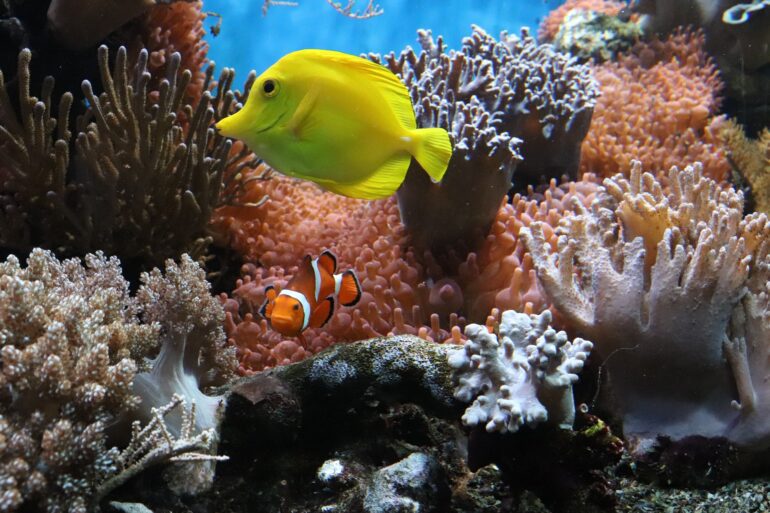TL;DR:
- Researchers at the University of Hawai’i at Mānoa have developed an AI-based tool for coral reef conservation.
- The tool uses deep learning algorithms to identify and measure reef halos from satellite images.
- Reef halos are ring-like patterns of bare sand around coral patch reefs.
- The tool allows for efficient and accurate monitoring of reef halos on a global scale.
- Coral reefs face threats from overfishing, climate change, and other factors.
- Monitoring coral reef ecosystems at large scales and over time is challenging.
- The tool aims to improve the understanding and management of coral reef ecosystems.
- Computer vision techniques and satellite imaging advancements have been instrumental in the development of the tool.
- The identification of reef halos required the integration of different deep learning algorithms.
- The tool can accurately identify over 90% of halos in some regions.
- It represents a significant step towards scaling up coral reef ecosystem monitoring.
- The goal is to develop a web app for remote and cost-effective reef health monitoring using satellite or drone imagery.
Main AI News:
Cutting-edge artificial intelligence technology has paved the way for a groundbreaking coral reef conservation tool, thanks to the efforts of researchers at the University of Hawai’i at Mānoa. By harnessing the power of novel deep learning algorithms, coral ecologists from the university’s School of Ocean and Earth Science and Technology have successfully identified and measured reef halos from space, revolutionizing the field of coral reef monitoring and conservation. The findings of their study were recently published in the esteemed journal Remote Sensing of Environment.
Reef halos, also referred to as grazing halos or sand halos, are distinctive ring-like patterns of bare sand that encompass coral patch reefs. These visually conspicuous features can be readily observed from satellite images. In the past, measuring and tracking reef halos posed a significant challenge, requiring substantial time and effort. However, with the introduction of this cutting-edge methodology, researchers can now accurately identify and measure reef halos on a global scale, accomplishing the task in a fraction of the time it would take a human observer.
Coral reefs, which serve as one of the planet’s most diverse ecosystems, are facing multiple threats, including overfishing, climate change, and various other factors. Given their crucial importance to millions of people worldwide, monitoring these delicate ecosystems at large scales and over extended periods has proven to be an arduous task. Driven by the desire to enhance the understanding and management of coral reef ecosystems, the team at the University of Hawai’i is committed to developing a freely accessible remote sensing tool. This tool will enable the monitoring of ecological processes on a large scale, even in remote and otherwise inaccessible regions.
Elizabeth Madin, the senior author of the study and an associate research professor at the Hawai’i Institute of Marine Biology, emphasizes the potential of reef halos as an emerging opportunity for monitoring reef ecosystems’ functionality. Madin states, “Reef halos may represent an emerging opportunity to monitor reef ecosystems’ function at large scales, including in remote and otherwise inaccessible areas.” The team’s cutting-edge research builds upon the increasingly prevalent use of computer vision techniques in medical and biological studies. In the realm of ecology, the amalgamation of image analysis and satellite imaging advancements has significantly improved the analysis of large-scale ecosystems and wildlife conservation efforts.
The successful identification of halos, a complex ecological pattern with substantial variation, required the integration of different deep learning algorithms. While some reef halos are clearly discernible in satellite imagery due to distinct edges and high contrast with the background vegetation, others may appear faint and challenging to distinguish, even to a highly trained observer.
Dr. Simone Franceschini, lead author of the study and a postdoctoral research fellow at the university’s Madin Lab, explains, “In the end, our team was able to develop a set of algorithms capable of taking into account the diversity of these patterns globally and identify and measure halos with surprising accuracy. It is hugely satisfying for us to now have built something that can accurately identify more than 90% of halos in some parts of the world.”
This breakthrough in coral reef monitoring represents a significant advancement in our ability to monitor and quantify various aspects of coral reef ecosystem health on a global scale. By providing a more efficient and effective method for measuring coral patch reefs and their surrounding halos, this innovative approach sets the stage for the development of a comprehensive reef conservation and monitoring tool based on the phenomenon of reef halos. Looking ahead, the research team aims to develop a user-friendly web application that will enable conservation practitioners, scientists, and resource managers to remotely, rapidly, and cost-effectively monitor reef health using satellite or drone imagery.
Conlcusion:
The development of an AI-based coral reef conservation tool by researchers at the University of Hawai’i at Mānoa holds promising implications for the market. This innovative technology, utilizing deep learning algorithms and satellite imaging, enables efficient and accurate monitoring of reef halos on a global scale. With coral reefs facing numerous threats and the increasing need for sustainable management, this tool presents an opportunity for businesses operating in the marine conservation and environmental sectors.
By providing valuable insights into coral reef health and ecosystem functionality, the tool can support informed decision-making, strategic planning, and the development of targeted conservation initiatives. Moreover, the potential future availability of a user-friendly web app for remote monitoring further enhances its market relevance and accessibility. As demand for sustainable practices and environmental stewardship continues to grow, businesses that leverage this cutting-edge technology can position themselves as leaders in coral reef conservation efforts while contributing to the preservation of these vital ecosystems.

